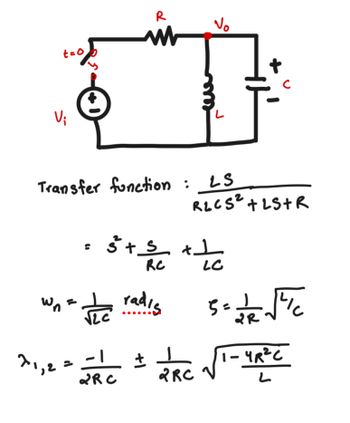
Vi(t) (a DC input voltage) is connected to the circuit at t=0, Vo(t) (across L and C) is the output.
The answer to the first three questions are provided in the picture.
a) Find the impedance of L and C using s=jω and find the second order transfer function after Vi(t) is connected where s is a complex number.
b) What is the canonical second order charecteristic polynomial?
c) In terms of R,L,C derive an expression for ωn and ζ and find the poles of the system.
d) what are the possible general solutions for Vo(t) considering this system could be overdamped, critically damped or underdamped. set up to find initial conditions. start by considering the circuit at t < 0, t = 0 and finding a second order D.E. and set up the poles of the system and v(t) at t tends to infinity. be as specific as possible with the answers.

Step by stepSolved in 2 steps

- I don't understand how to find this output from the given transfer function and input?arrow_forwardI don't understand how to find this output from the given transfer function and input?arrow_forwardDifferential equation Find the steady-state current in an LRC circuit when L =1/2h, R = 20Ω, C = 0.001f and E(t) = 100 sen 60t 200 cos 40tV.arrow_forward
 Introductory Circuit Analysis (13th Edition)Electrical EngineeringISBN:9780133923605Author:Robert L. BoylestadPublisher:PEARSON
Introductory Circuit Analysis (13th Edition)Electrical EngineeringISBN:9780133923605Author:Robert L. BoylestadPublisher:PEARSON Delmar's Standard Textbook Of ElectricityElectrical EngineeringISBN:9781337900348Author:Stephen L. HermanPublisher:Cengage Learning
Delmar's Standard Textbook Of ElectricityElectrical EngineeringISBN:9781337900348Author:Stephen L. HermanPublisher:Cengage Learning Programmable Logic ControllersElectrical EngineeringISBN:9780073373843Author:Frank D. PetruzellaPublisher:McGraw-Hill Education
Programmable Logic ControllersElectrical EngineeringISBN:9780073373843Author:Frank D. PetruzellaPublisher:McGraw-Hill Education Fundamentals of Electric CircuitsElectrical EngineeringISBN:9780078028229Author:Charles K Alexander, Matthew SadikuPublisher:McGraw-Hill Education
Fundamentals of Electric CircuitsElectrical EngineeringISBN:9780078028229Author:Charles K Alexander, Matthew SadikuPublisher:McGraw-Hill Education Electric Circuits. (11th Edition)Electrical EngineeringISBN:9780134746968Author:James W. Nilsson, Susan RiedelPublisher:PEARSON
Electric Circuits. (11th Edition)Electrical EngineeringISBN:9780134746968Author:James W. Nilsson, Susan RiedelPublisher:PEARSON Engineering ElectromagneticsElectrical EngineeringISBN:9780078028151Author:Hayt, William H. (william Hart), Jr, BUCK, John A.Publisher:Mcgraw-hill Education,
Engineering ElectromagneticsElectrical EngineeringISBN:9780078028151Author:Hayt, William H. (william Hart), Jr, BUCK, John A.Publisher:Mcgraw-hill Education,





